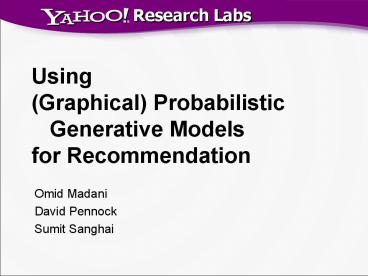Using Graphical Probabilistic Generative Models for Recommendation - PowerPoint PPT Presentation
1 / 19
Title:
Using Graphical Probabilistic Generative Models for Recommendation
Description:
Latent Dirichelet Allocation (LDA) Discussion. Research Labs ... Internet Movie Database (IMDb) The Internet Movie Database (www.imdb.com) Questions ... – PowerPoint PPT presentation
Number of Views:140
Avg rating:3.0/5.0
Title: Using Graphical Probabilistic Generative Models for Recommendation
1
Using(Graphical) Probabilistic Generative
Modelsfor Recommendation
- Omid Madani
- David Pennock
- Sumit Sanghai
2
Overview
- What is a probabilistic generative model?
- What are graphical models?
- ExampleLatent Dirichelet Allocation (LDA)
- Discussion
3
What is a Probabilistic Generative Model?
- 1. Assume some parameterized random process
generates the data we see - 1b. (Optional) Learn the parameter values that
best explain the data - 2. Use the model to predict (infer) new data
based on data seen so far - Benefits
- Can focus on modeling forward process more
natural, easier to do -- known algs for learning,
inference, value of information, etc. - Assumptions are explicit, up front
4
Simple (useless) example
- Assume there are 2 ( only 2) types of people
easily pleased and cynical - They occur with equal frequency
- They rate movieswith probability
- We see data user1 AAFAAAAAAFAA
- Infer probability user is easily pleased
- Predict likely next rating (A)
A F
easily pleased cynical
0.1
0.9
0.9
0.1
5
Simple (useless) examplewith learning
- Assume there are 2 ( only 2) types of people,
occurring with equal frequency - They rate movieswith probability
- We see data user1, user2, user3, ...
- Learn p1, p2 (e.g., max likelihood)
- Infer probability a given user is type 1/2
- Predict likely next rating
A F
type 1 type 2
1-p1
p1
1-p2
p2
6
Example Personality Diagnosis
- User is personality type isritrue
- Assumption 1. User is reported rating for title
j is drawn from an independent normal
distribution with mean ritrue Pr(rijx
rijtruey) ? e-(x-y)2/2?2where ? is a free
parameter.
7
PD Model
- Assumption 2. The distribution of personality
types in the database is representative of the
target population. - Pr(ratrueri) 1/n
8
PD Model Inference
- Probability that the active user is of the same
personality type as any other user, given the
active users ratings. - Pr(ratrueri ra1x1, , ramxm)
- ? Pr(ra1x1 ra1trueri1) ???
- Pr(ramxm ramtruerim) ? Pr(ratrueri)
9
PD Model Inference
- Probability distribution for the active users
ratings of unseen titles, j?NR. - Pr(rajxj ra1x1, , ramxm)
- ?i1 Pr(rajxj ratrueri) ?
- Pr(ratrueri ra1x1, , ramxm)
- Prediction most probable rating
- Time and space complexity O(n m)
n
10
Graphical Models
- Standardized way to depict probabilistic
generative models graphically, incl params - Easier to hand-create models easier to
understand/interpret learned models - Can build quite complex models Off the shelf
algorithms exist for learning inference that
can work efficiently
11
Other Graphical Models
Hofmann aspect model probabilistic LSI
Popescul et al. 3-wayaspect model
user
user
style
style
movie
movie
actor
12
Personality Diagnosis Graphical Model
ritrue
N(ra1true,?2)
ra1
ri2
rij
rim
...
...
13
Internet Movie Database (IMDb)
Source Jensen 2004
- The Internet Movie Database (www.imdb.com)
- Questions
- What predicts box office receipts?
- Are awards important?
- What about previouscommercial success?
- Do ticket buyers careabout studios, or
onlyabout actors anddirectors?
14
Example Learned Model
Source Jensen 2004
15
More on Graphical Models
- Structures that allow
- Modularity ? Inference
- Interpretability ? Extensibility
- Examples
- Markov models Bayes nets
- Markov random fields
- LSI (PCA), probabilistic LSI, LDA, ...
16
Example Dirichelet Allocation
- Given,
- V words, e.g., win, game, vote
- k topics, e.g., politics, sports
- Matrix of word-given-topic probabilities
(e.g. P(winsports).5) - Dirichelet density D over topics, specified by
, e.g. uniform where
17
Topics are multinomials over words
win game vote
Sports Politics
0.5
0.5
0
0.05
0.35
0.6
18
DA Model
- To generate a document
- Sample doc length N from Poisson
- Sample from D (e.g., )
- Repeat N times
- Draw a topic z with 1/3 probability zsports,
2/3 zpolitics - Draw a word from the topic z
19
The DA Graph
20
Latent Dirichelet Allocation
- Task given k and a corpus, learn
- Matrix
- Dirichelet parameters
- Method EM
21
Types of Inference/Uses
- Dimensionality reduction
- Document similarity
- Word similarity
- Clustering
22
Applications
- Blei et. al. (2003) applied it to EachMovie
dataset - User as document, movie as a word
- topic as ..
- 10-20 latent topics found
- Perplexity significantly better than pLSI and
document as single mixture
23
Benefits of Graphical Models
- Structures that allow
- Modularity, interpretability, extensibility
- Inference
- known semantics
- provide probabilities
- handle missing values
- value of information (e.g. use in active
learning)
24
Active Research
- Tractability of inference
- Sparse data and over-fitting
- Fidelity of the models to real world
- E.g., multinomial appropriate?
- More sophisticated models
- nested Chinese process, author-topic,
hierarchical, modeling word order, relation
models, ... - Active learning































